 W
WArnolfini is an international arts centre and gallery in Bristol, England. It has a programme of contemporary art exhibitions, artist's performance, music and dance events, poetry and book readings, talks, lectures and cinema. There is also a specialist art bookshop and a café bar. Educational activities are undertaken and experimental digital media work supported by online resources. A number of festivals are regularly hosted by the gallery.
 W
WThe Ashton Avenue Bridge is a former road-rail bridge in Bristol, England. Grade II listed, it was constructed as part of the Bristol Harbour Railway, and now carries a guided busway and a local access cycle path.
 W
WB Bond Warehouse is a former bonded warehouse built to serve Bristol Harbour.
 W
WMV Balmoral is a vintage excursion ship owned by MV Balmoral Fund Ltd., a preservation charity. Her principal area of operation is the Bristol Channel, although she also operates day excursions to other parts of the United Kingdom. The Balmoral is included on the National Historic Ships register as part of the National Historic Fleet.
 W
WBathurst Basin is a small triangular basin adjoining the main harbour of the city of Bristol, England. The basin takes its name from Charles Bathurst, who was a Bristol MP in the early 19th century.
 W
WBristol Bridge is a bridge over the floating harbour in Bristol, England, the original course of the River Avon. It is a grade II listed building.
 W
WThe Bristol Feeder Canal is a body of water in Bristol, England, that connects the Floating Harbour with the River Avon.
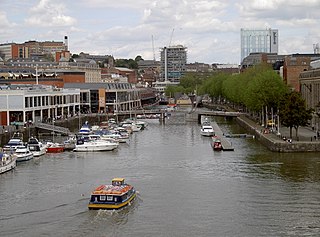 W
WBristol Ferry Boats is a brand of water bus services operating around Bristol Harbour in the centre of the English city of Bristol, using a fleet of distinctive yellow and blue painted ferry boats. The services were formerly owned by the Bristol Ferry Boat Company, but are now the responsibility of Bristol Community Ferry Boats, a community interest company that acquired the fleet of the previous company.
 W
WBristol General Hospital was a healthcare facility in Guinea Street, Harbourside, Bristol, in the south west of England. It opened in 1832, and closed in 2012. The BGH was managed by the University Hospitals Bristol NHS Foundation Trust. The building has since been converted into apartments.
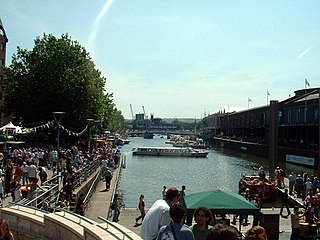 W
WBristol Harbour is the harbour in the city of Bristol, England. The harbour covers an area of 70 acres. It has existed since the 13th century but was developed into its current form in the early 19th century by installing lock gates on a tidal stretch of the River Avon in the centre of the city and providing a tidal by-pass for the river. It is often called the Floating Harbour as the water level remains constant and it is not affected by the state of the tide on the river.
 W
WThe Bristol Harbour Festival is a festival held annually in the English city of Bristol, and which the celebrates the city's maritime heritage and the importance of Bristol's docks and harbour. Most of the activities, including live music, street performances, fireworks and a variety of other live entertainments, are held on or near the waterfront of Bristol Harbour. Venues include Queen Square, Lloyds Amphitheatre, Millennium Square and Castle Park, with seagoing vessels moored nearby. The liveliest part of the festival is quayside, but the main attractions are entertainment designed to engage all the communities of Bristol, as well as entertain the thousands of visitors to the city.
 W
WThe Bristol Harbour Railway was a standard-gauge industrial railway that served the wharves and docks of Bristol, England. The line, which had a network of approximately 5 mi (8.0 km) of track, connected the Floating Harbour to the GWR mainline at Bristol Temple Meads. Freight could be transported directly by waggons to Paddington Station in London. The railway officially closed in 1964.
 W
WThe Bristol Industrial Museum was a museum in Bristol, England, located on Prince's Wharf beside the Floating Harbour and which closed in 2006. On display were items from Bristol's industrial past – including aviation, car and bus manufacture, and printing – and exhibits documenting Bristol's maritime history. The museum was managed by Bristol City Council along with nearby preserved industrial relics along Prince's Wharf, including the Bristol Harbour Railway, cranes and a small fleet of preserved vessels. The railway, cranes and vessels all now form part of the working exhibits at M Shed Museum.
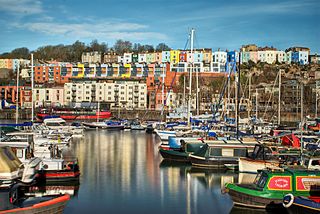 W
WThe Bristol Marina is located in Bristol Harbour, Bristol, England. The marina has been in operation since 1980. It is situated adjacent to the SS Great Britain on the south side of the harbour on the site of the former Charles Hill & Sons Ltd's Albion Dockyard, which it shares with Abels Shipbuilders.
 W
WBristol Packet Boat Trips is a limited company offering public and charter excursions in Bristol Harbour and on the River Avon. The company has four boats: the river launch Tower Belle, narrowboat Redshank, glass-topped Bagheera and locally built Flower of Bristol. The company also has an interest in Bristol Hydrogen Boats which has commissioned and built a hydrogen powered ferry boat.
 W
WBristol Temple Meads is the oldest and largest railway station in Bristol, England. It is an important transport hub for public transport in the city. In addition to the train services there are bus services to many parts of the city and surrounding districts, and a ferry to the city centre. Bristol's other major station, Bristol Parkway, is on the northern outskirts of the conurbation.
 W
WThe Clifton Rocks Railway was an underground funicular railway in Bristol, England, linking Clifton at the top to Hotwells and Bristol Harbour at the bottom of the Avon Gorge in a tunnel cut through the limestone cliffs.
 W
WThe Cumberland Basin is the main entrance to the docks of the city of Bristol, England. It separates the areas of Hotwells from the tip of Spike Island.
 W
WA Fairbairn crane is a type of crane of an 'improved design', patented in 1850 by Sir William Fairbairn. There are numerous hand-powered versions around the world and one surviving steam-powered example in Bristol Docks, England.
 W
WFinzels Reach is a 4.7-acre (1.9 ha) mixed use development site located in central Bristol, England, on a former industrial site, which occupies most of the south bank of Bristol Floating Harbour between Bristol Bridge and St Philip's Bridge, across the river from Castle Park.
 W
WThe Granary is a building on Welsh Back, Bristol, England.
 W
WThe Great Bristol Half Marathon is an annual road running event held on the streets of Bristol, UK. The route is at sea level and starts on Anchor Road outside We The Curious. Participants make their way toward Hotwells before heading under the Clifton Suspension Bridge and along the Portway toward Sea Mills before returning the same way then navigating around Cumberland Basin then along Spike Island before crossing Prince Street Bridge, circling Queen Square then heading to Castle Park via St Mary Redcliffe and Temple Circus. The final mile and a half take place in the Old City and Bristol city centre before crossing the finish line back at Anchor Road.
 W
WSS Great Britain is a museum ship and former passenger steamship, which was advanced for her time. She was the longest passenger ship in the world from 1845 to 1854. She was designed by Isambard Kingdom Brunel (1806–1859), for the Great Western Steamship Company's transatlantic service between Bristol and New York City. While other ships had been built of iron or equipped with a screw propeller, Great Britain was the first to combine these features in a large ocean-going ship. She was the first iron steamer to cross the Atlantic Ocean, which she did in 1845, in the time of 14 days.
 W
WHotwells is a district of the English port city of Bristol. It is located to the south of and below the high ground of Clifton, and directly to the north of the Floating Harbour. The southern entrance to the Avon Gorge, which connects the docks to the sea, lies at the western end of Hotwells. The eastern end of the area is at the roundabout where Jacobs Well Road meets Hotwell Road. Hotwells is split between the city wards of Clifton, and Hotwells and Harbourside.
 W
WThe Hydraulic engine house is part of the "Underfall Yard" in Bristol Harbour in Bristol, England.
 W
WM Shed is a museum in Bristol, England, located on Prince's Wharf beside the Floating Harbour in a dockside transit shed formerly occupied by Bristol Industrial Museum. The museum's name is derived from the way that the port identified each of its sheds. M Shed is home to displays of 3,000 Bristol artefacts and stories, showing Bristol's role in the slave trade and items on transport, people, and the arts. Admission is free.
 W
WThe Matthew is a replica of a caravel sailed by John Cabot in 1497 from Bristol to North America, presumably Newfoundland.
 W
WMillennium Square is a location in the centre of Bristol, England. It was built as part of the At Bristol development, and has become a popular public area.
 W
WNetham Lock is the point at Netham in Bristol at which boats from the River Avon, acting as part of the Kennet and Avon Canal, gain access to Bristol's Floating Harbour.
 W
WThe New Cut is an artificial waterway which was constructed between 1804 and 1809 to divert the tidal river Avon through south and east Bristol, England. This was part of the process of constructing Bristol's Floating Harbour, under the supervision of engineer William Jessop. The cut runs from Totterdown Basin at the eastern end of St Phillip's Marsh, near Temple Meads, to the Underfall sluices at Rownham in Hotwells and rejoining the original course of the tidal Avon.
 W
WThe New Gaol is in Cumberland Road, Spike Island, Bristol, England, near Bristol Harbour.
 W
WThe Nova Scotia is a historic nineteenth century public house situated on Spike Island adjacent to the Cumberland Basin in Bristol Harbour in Bristol, England. It was originally built as a terrace of three houses and then converted into a pub. It is a grade II listed building. It was a coaching inn and traces of large lanterns and the entrance to the coach yard survive.
 W
WPero's Bridge is a pedestrian bascule bridge that spans St Augustine's Reach in Bristol Harbour, Bristol, England. It links Queen Square and Millennium Square.
 W
WPrince Street Bridge is a swing bridge across Bristol Harbour. It is now Grade II listed. The bridge carries a road from Prince Street to Wapping Road and is located between the Arnolfini art centre and M Shed museum.
 W
WThe Pump House is a historic public house situated in Hotwells on Bristol Harbour, Bristol, England. It is a grade II listed building.
 W
WPyronaut is a specialised form of fireboat known as a fire-float. It was built in 1934 by Charles Hill & Sons Ltd., Albion Dock Bristol, Yard No. 208. Registered number 333833. She is owned by Bristol Museums and based at M Shed in Bristol's Floating Harbour.
 W
WRedcliffe, also known as Redcliff, is a district of the English port city of Bristol, adjoining the city centre to the northwest. It is bounded by the loop of the Floating Harbour to the west, north and east, together with the New Cut of the River Avon to the south. Most of Redcliffe lies within the city ward of Lawrence Hill, although the westernmost section, including the cliffs and hill from which the area takes its name, is in Cabot ward. Bristol Temple Meads station is located in Redcliffe.
 W
WRedcliffe, also known as Redcliff, is a district of the English port city of Bristol, adjoining the city centre to the northwest. It is bounded by the loop of the Floating Harbour to the west, north and east, together with the New Cut of the River Avon to the south. Most of Redcliffe lies within the city ward of Lawrence Hill, although the westernmost section, including the cliffs and hill from which the area takes its name, is in Cabot ward. Bristol Temple Meads station is located in Redcliffe.
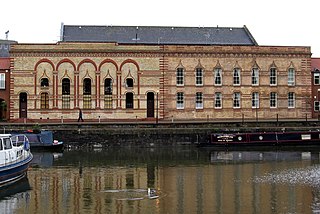 W
WRobinson's Warehouse is a warehouse on Bathurst Parade, on the Floating Harbour in Bristol, England.
 W
WTemple Quay is an area of mixed-use development in central Bristol, England. The project was initiated by Bristol Development Corporation in 1989, under the name Quay Point until 1995. In that year it was handed over to English Partnerships, under whom development eventually started in 1998. It is bounded by Temple Way to the west and Bristol Temple Meads railway station to the southeast; to the northeast the development was bounded by Bristol Floating Harbour until 2002, when development of Temple Quay North started on the harbour's other side. In 2012 the whole area became part of Bristol Temple Quarter Enterprise Zone.
 W
WThe Centre is a public open space in the central area of Bristol, England, created by covering over the River Frome. The northern end of The Centre, known as Magpie Park, is skirted on its western edge by Colston Avenue; the southern end is a larger paved area bounded by St Augustine's Parade to the west, Broad Quay the east, and St Augustine's Reach to the south, and bisected by the 2016 extension of Baldwin Street. The Centre is managed by Bristol City Council.
 W
WThekla is a former cargo ship moored in the Mud Dock area of Bristol's Floating Harbour, England. The ship was built in Germany in 1958 and worked in the coastal trades.
 W
WTower Belle is a passenger boat based in Bristol Harbour in England. The vessel is operated by the Bristol Packet Boat Trips company on pleasure and educational trips in the City Docks, on the River Avon to the Chequers Inn at Hanham Lock and Beese's Tea Gardens at Conham. Tower Belle was built in 1920 in Newcastle upon Tyne by Armstrong Whitworth, originally known as Wincomblee. In the 1950s and 1960s she worked in London, finally coming to Bristol in 1976.
 W
WThe Underfall Yard is a historic boatyard on Spike Island serving Bristol Harbour, the harbour in the city of Bristol, England.
 W
WJoseph Walter (1783–1856) was an English marine painter in oils and watercolour, working at Bristol and Portishead. He gained notice for his portrayals of Brunel's steamships Great Western and Great Britain.
 W
WWatershed opened in June 1982 as the United Kingdom's first dedicated media centre. Based in former warehouses on the harbourside at Bristol, it hosts three cinemas, a café/bar, events/conferencing spaces, the Pervasive Media Studio, and office spaces for administrative and creative staff. It occupies the former E and W sheds on Canon's Road at Saint Augustine's Reach, and underwent a major refurbishment in 2005. The building also hosts UWE eMedia Business Enterprises, Most of Watershed's facilities are situated on the second floor of two of the transit sheds. The conference spaces and cinemas are used by many public and private sector organisations and charities. Watershed employs the equivalent of over seventy full-time staff and has an annual turnover of approximately £3.8 million. As well as its own commercial income, Watershed Arts Trust is funded by national and regional arts funders.
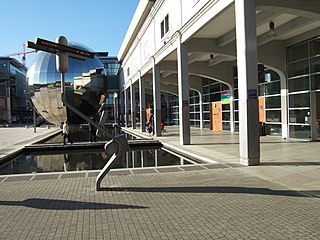 W
WWe The Curious is a science and arts centre and educational charity in Bristol, England.